It’s that time of year again when thoughts about holiday gifts creep into our minds more and more often. Only this year as last, finding the funds for even token gifts is out of the question for many people. But not to worry. There are several great gifts we can give our pets this holiday season that don’t cost a cent. Not only that, these gifts will lead their recipients to bestow different, but equally enjoyable gifts upon us.
Let’s begin with our gifts to our pets. Over the years I’ve noticed that my animals—both cats and dogs—engage in more creative play with themselves and each other at very specific times. One of these is in the morning when I’m doing yoga. Another is when I’m in the office immersed in writing or other work-related projects I enjoy. Yet another is when I’m engrossed in household chores indoors and out that I find equally rewarding.
My quest to find the connection between those times and the animal behavioral results led me to first focus on the yoga sessions. I did this because, unlike the other two activity patterns that may or may not occur on any given day, I do yoga 6 days a week. First, I considered any differences in the physical environment that might trigger the increased play. Perhaps the presence of the foot-friendly mats on the old, uneven pine plank flooring triggered the behavior.
But the more aware I became of these self-initiated animal play sessions, the more I realized that I had unknowingly supplied a vital ingredient: an emotional environment in which such creative play was possible. Those periods when I was happily focused on something else, i.e. when I felt physically and mentally comfortable, gave them the freedom to amuse themselves. And for them that meant making up games to play with themselves and each other.
When I was younger, had lots of time and energy, and knew little about animal emotion, cognition, and ethology, I was the typical helicopter companion animal-owner. If anything, I was worse than the average pet-owner because I was, after all, an animal-care professional so naturally my animals must receive the very best care. When I wasn’t hovering over them, I was trying to micro-manage them to ensure my idea of a perfect life for them. If that meant engaging them and myself in activities I lacked the time or desire to engage in, I either forced myself to or felt guilty if I didn’t. In retrospect and if animals truly did speak on Christmas Eve, I can easily imagine any one of my animals during that period grousing, “Geez, I wish she’d get a life and give us a break!” while the others vigorously nodded in agreement.
So the first free but nonetheless priceless gift we can give our animals is to get a life that frees them from the burden of being the center of our universes. And the second is to be happy and comfortable with who and what we are in that life.
Now if you find yourself thinking, “What an outrageous, [expletive deleted] crock of animal excrement that is!” following by an endless list of all the reasons why no one in their right mind could feel happy and comfortable given the recession, climate change, the idiots at work, stupid politicians, etc.,” let’s have a reality check here. First, no one but we are responsible for our feelings about anything. We might not be able to control what happens to us, but we always can control how we feel about those events. Second, unless we buck up and get a grip, we’re going to miss out on the fantastic freebie gifts our pets can give us in the form of the most enchanting, intelligent, and creative games they make up when they live in a physically and mentally stable environment that only we can provide.
Let’s look at some examples.
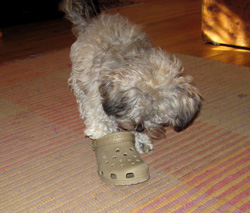 When I or someone else tosses Ollie’s ball for him, he delights in bringing it back as much as we delight in him doing this. When Bamboo the cat is inside during these sessions, sometimes he’ll hide behind the couch and leap out at Ollie as Ollie flies by which is even more fun. But when I’m doing yoga, Ollie takes his ball and stuffs it into the end of one of my Crocs where it’s held by the raised nubs inside the shoe. Then he flips the shoe with his nose or digs at it with his paws in an attempt to free the ball.
When I or someone else tosses Ollie’s ball for him, he delights in bringing it back as much as we delight in him doing this. When Bamboo the cat is inside during these sessions, sometimes he’ll hide behind the couch and leap out at Ollie as Ollie flies by which is even more fun. But when I’m doing yoga, Ollie takes his ball and stuffs it into the end of one of my Crocs where it’s held by the raised nubs inside the shoe. Then he flips the shoe with his nose or digs at it with his paws in an attempt to free the ball.
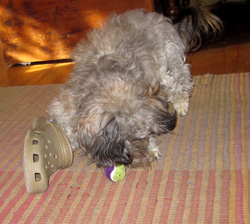 Other times, he’ll flip up the accent pillow on the dog-couch or the cushion in the dog-bed in the office and drop the ball under it. Once he’s hidden the ball, he’ll then amuse himself by pulling the pillow up high with his front paws, then reaching down and grabbing the ball with his teeth. If he doesn’t get the pillow up high enough or is too slow, the pillow smacks him on the head before he gets the ball and he starts over again. Once he gets the ball, he buries it and tries to rescue it from the evil pillow yet again. This is accompanied by wonderful grunts, growls, and squeals that make it clear no pillow is going to get the best of him!
Other times, he’ll flip up the accent pillow on the dog-couch or the cushion in the dog-bed in the office and drop the ball under it. Once he’s hidden the ball, he’ll then amuse himself by pulling the pillow up high with his front paws, then reaching down and grabbing the ball with his teeth. If he doesn’t get the pillow up high enough or is too slow, the pillow smacks him on the head before he gets the ball and he starts over again. Once he gets the ball, he buries it and tries to rescue it from the evil pillow yet again. This is accompanied by wonderful grunts, growls, and squeals that make it clear no pillow is going to get the best of him!
Outside when I’m otherwise engrossed, Ollie, Frica, and Bamboo engage on a variation of the stalking game Ollie and Bam play when someone throws Ollie’s ball. In this animals-only version, the dogs chase each other while the cat stalks them belly low to the ground, then charges and leaps over the two of them as they run by. If he lands on top on them—by accident or intent—they form a rolling cat-and-dog ball that drunkenly weaves around the yard. Eventually, this dissolves into a game of Chase-the-Cat, complete with ferocious barking and breath-taking leaps and bounds all accomplished at warp speed.
Here’s a picture of Bam trying to break up a wrestling match between Ollie and Fric:
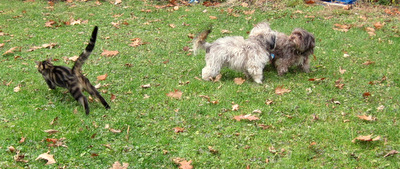
And Ollie’s response to that:
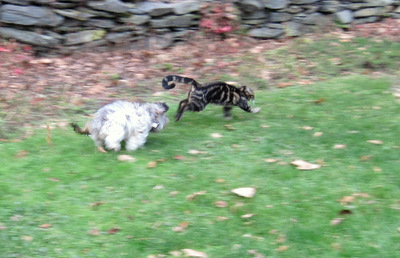
All I need to do to disrupt these and other animal games is to interfere. Because of this, I’ve mustered the self-control necessary to surreptitiously enjoy their antics and all the good feelings these generate for all of us.
Two of Frica’s offspring, Dilly and Finnegan, love to play alone as well as with each other, too. And like a lot of cats and dogs in physically and mentally secure environments, they use different body language when they’re playing with a toy alone versus when they want another animal to play with the toy with them. It’s not that these animals are overtly possessive of the toy when they want to play alone. They just appear more self-contained at those times, which is usually enough to cause any other animals to find some way to amuse themselves, too.
On the other hand, animals who want to engage other animals in play may use a variety of displays to entice them. In addition to the familiar canine play bow with head down and front legs extended and rear end up that signals this message, some dogs will seductively wave a toy while giving come-hither looks while others will practically shove the toy in the other dog’s mouth. Animals who know their playmates well also may dispense with the play bow and cut to the chase—literally. Dogs who routinely play with cats also may skip the bow because many cats don’t recognize its meaning and see it more as an invitation to jump on the dog’s head. Because the increased incidence of hip and knee problems and/or other medical conditions may make assuming the play bow more difficult, it wouldn’t surprise me if dogs start to make up more behaviors that, to them, signal a desire to play. The challenge is ensuring that any playmates or humans understand what the new signal means.
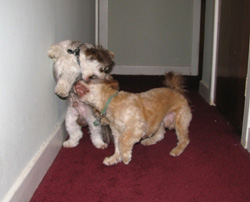 And speaking of play-fighting, don’t spoil the game by imposing some decorous standard on rough and tumble dog or cat play. True this mock battle between Finn and Dilly can look pretty scary if you don’t know the context in which this occurred.
And speaking of play-fighting, don’t spoil the game by imposing some decorous standard on rough and tumble dog or cat play. True this mock battle between Finn and Dilly can look pretty scary if you don’t know the context in which this occurred.
But in addition to providing a physically and mentally secure space where play can occur, learning what our pets’ body language means in a particular context is another great free gift we can give them.
Frica and her offspring and Bamboo are great at making up games that are athletic and even raucous. Another dog I know, Cozy, amuses herself with more refined and artistic endeavors. Below are pictures of two of her creations:
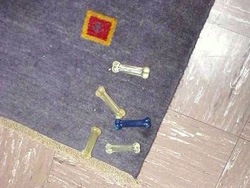
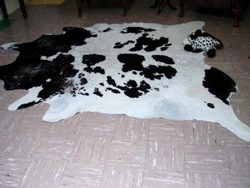
How could anyone not be charmed by the mind and spirit of an animal who created such tableaux of composition in her free time? And who could do anything other than laugh and marvel when such a dog discovered that, if she dragged an accent pillow to just the right place on the floor and jumped on it, she could then play in the dust motes that flew up and were illuminated by the sun?
If you’re like me, the more you think about how your own and other animals amuse themselves, the more examples will occur to you. And every one of them will make you smile and feel good about them and yourself.
Isn’t that really what the holiday spirit is all about?
If you have any comments regarding subject matter, favorite links, or anything you’d like to see discussed on or added to this site, please let me know at mm@mmilani.com.
It’s that time of year again when thoughts about holiday gifts creep into our minds more and more often. Only this year as last, finding the funds for even token gifts is out of the question for many people. But not to worry. There are several great gifts we can give our pets this holiday season that don’t cost a cent. Not only that, these gifts will lead their recipients to bestow different, but equally enjoyable gifts upon us.
Let’s begin with our gifts to our pets. Over the years I’ve noticed that my animals—both cats and dogs—engage in more creative play with themselves and each other at very specific times. One of these is in the morning when I’m doing yoga. Another is when I’m in the office immersed in writing or other work-related projects I enjoy. Yet another is when I’m engrossed in household chores indoors and out that I find equally rewarding.
My quest to find the connection between those times and the animal behavioral results led me to first focus on the yoga sessions. I did this because, unlike the other two activity patterns that may or may not occur on any given day, I do yoga 6 days a week. First, I considered any differences in the physical environment that might trigger the increased play. Perhaps the presence of the foot-friendly mats on the old, uneven pine plank flooring triggered the behavior.
But the more aware I became of these self-initiated animal play sessions, the more I realized that I had unknowingly supplied a vital ingredient: an emotional environment in which such creative play was possible. Those periods when I was happily focused on something else, i.e. when I felt physically and mentally comfortable, gave them the freedom to amuse themselves. And for them that meant making up games to play with themselves and each other.
When I was younger, had lots of time and energy, and knew little about animal emotion, cognition, and ethology, I was the typical helicopter companion animal-owner. If anything, I was worse than the average pet-owner because I was, after all, an animal-care professional so naturally my animals must receive the very best care. When I wasn’t hovering over them, I was trying to micro-manage them to ensure my idea of a perfect life for them. If that meant engaging them and myself in activities I lacked the time or desire to engage in, I either forced myself to or felt guilty if I didn’t. In retrospect and if animals truly did speak on Christmas Eve, I can easily imagine any one of my animals during that period grousing, “Geez, I wish she’d get a life and give us a break!” while the others vigorously nodded in agreement.
So the first free but nonetheless priceless gift we can give our animals is to get a life that frees them from the burden of being the center of our universes. And the second is to be happy and comfortable with who and what we are in that life.
Now if you find yourself thinking, “What an outrageous, [expletive deleted] crock of animal excrement that is!” following by an endless list of all the reasons why no one in their right mind could feel happy and comfortable given the recession, climate change, the idiots at work, stupid politicians, etc.,” let’s have a reality check here. First, no one but we are responsible for our feelings about anything. We might not be able to control what happens to us, but we always can control how we feel about those events. Second, unless we buck up and get a grip, we’re going to miss out on the fantastic freebie gifts our pets can give us in the form of the most enchanting, intelligent, and creative games they make up when they live in a physically and mentally stable environment that only we can provide.
Let’s look at some examples.
Outside when I’m otherwise engrossed, Ollie, Frica, and Bamboo engage on a variation of the stalking game Ollie and Bam play when someone throws Ollie’s ball. In this animals-only version, the dogs chase each other while the cat stalks them belly low to the ground, then charges and leaps over the two of them as they run by. If he lands on top on them—by accident or intent—they form a rolling cat-and-dog ball that drunkenly weaves around the yard. Eventually, this dissolves into a game of Chase-the-Cat, complete with ferocious barking and breath-taking leaps and bounds all accomplished at warp speed.
Here’s a picture of Bam trying to break up a wrestling match between Ollie and Fric:
And Ollie’s response to that:
All I need to do to disrupt these and other animal games is to interfere. Because of this, I’ve mustered the self-control necessary to surreptitiously enjoy their antics and all the good feelings these generate for all of us.
Two of Frica’s offspring, Dilly and Finnegan, love to play alone as well as with each other, too. And like a lot of cats and dogs in physically and mentally secure environments, they use different body language when they’re playing with a toy alone versus when they want another animal to play with the toy with them. It’s not that these animals are overtly possessive of the toy when they want to play alone. They just appear more self-contained at those times, which is usually enough to cause any other animals to find some way to amuse themselves, too.
On the other hand, animals who want to engage other animals in play may use a variety of displays to entice them. In addition to the familiar canine play bow with head down and front legs extended and rear end up that signals this message, some dogs will seductively wave a toy while giving come-hither looks while others will practically shove the toy in the other dog’s mouth. Animals who know their playmates well also may dispense with the play bow and cut to the chase—literally. Dogs who routinely play with cats also may skip the bow because many cats don’t recognize its meaning and see it more as an invitation to jump on the dog’s head. Because the increased incidence of hip and knee problems and/or other medical conditions may make assuming the play bow more difficult, it wouldn’t surprise me if dogs start to make up more behaviors that, to them, signal a desire to play. The challenge is ensuring that any playmates or humans understand what the new signal means.
But in addition to providing a physically and mentally secure space where play can occur, learning what our pets’ body language means in a particular context is another great free gift we can give them.
Frica and her offspring and Bamboo are great at making up games that are athletic and even raucous. Another dog I know, Cozy, amuses herself with more refined and artistic endeavors. Below are pictures of two of her creations:
How could anyone not be charmed by the mind and spirit of an animal who created such tableaux of composition in her free time? And who could do anything other than laugh and marvel when such a dog discovered that, if she dragged an accent pillow to just the right place on the floor and jumped on it, she could then play in the dust motes that flew up and were illuminated by the sun?
If you’re like me, the more you think about how your own and other animals amuse themselves, the more examples will occur to you. And every one of them will make you smile and feel good about them and yourself.
Isn’t that really what the holiday spirit is all about?
If you have any comments regarding subject matter, favorite links, or anything you’d like to see discussed on or added to this site, please let me know at mm@mmilani.com.